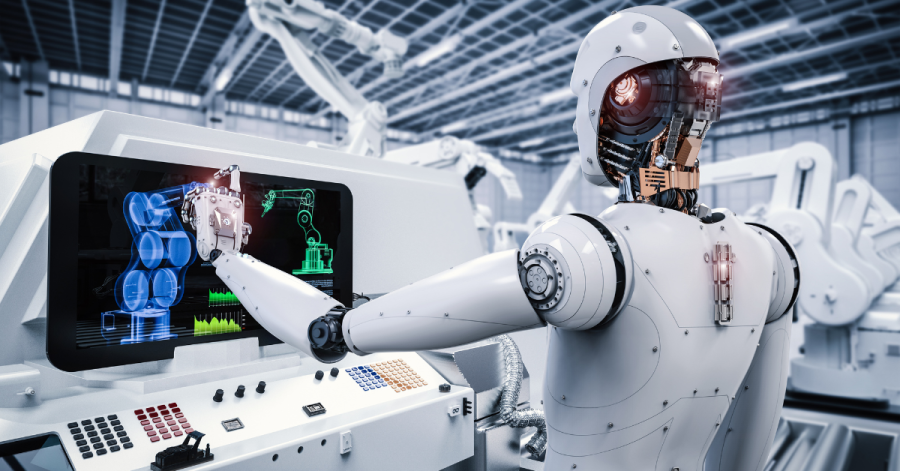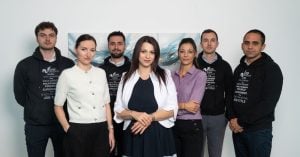The global robotics industry is experiencing significant growth, with the market size projected to increase from $16.78 billion in 2022 to $35.68 billion by 2029. As businesses worldwide anticipate a shift towards automation – with 90% planning to incorporate robotics innovations into their infrastructure by 2030 – regions around the globe are contributing to this technological evolution. Among them is Central and Eastern Europe (CEE), where various innovations in the field of robotics are emerging. In this article, we provide an overview of 15+ key robotics innovations being developed in the CEE region.
1. Collaborative Robots (Cobots)
Cobots, robots designed to work in tandem with humans, represent a significant leap forward in the field of robotics. In the CEE region, companies like Poland’s VersaBox are advancing the development of cobots. Their machines are designed to perform tasks in close physical collaboration with humans, enhancing productivity and safety in industrial settings. By taking over repetitive tasks, cobots free up human workers to focus on more complex and creative aspects of production, leading to increased efficiency and improved working conditions.
2. Medical Robotics
The intersection of robotics and healthcare has given rise to some of the most impactful innovations in deep tech. Hand-in-Scan, a Hungarian company, has developed a medical hand hygiene device that uses digital imaging and artificial intelligence to provide immediate, objective feedback on hand sanitation. This technology is crucial in healthcare settings, where proper hand hygiene can significantly reduce the risk of healthcare-associated infections.
3. Agricultural Robots
Robotics is revolutionizing the agricultural sector, making farming more efficient and sustainable. Poland’s Plantalux, for instance, has developed horticultural LED lighting systems that interact with crops. This form of agri-robotics optimizes plant growth conditions, improving crop yield and reducing resource usage. By automating and optimizing various farming processes, agricultural robots are helping to meet the growing demand for food in a more sustainable way.
4. Robotics Innovations in Education
Robotics has application in education, making learning more interactive and engaging. RoboCamp, a company based in Poland, offers educational programs that use robotics to teach programming and problem-solving skills. By integrating robotics into the curriculum, RoboCamp is helping to prepare the next generation of innovators and problem solvers.
5. Industrial Automation
Industrial robots are a cornerstone of modern manufacturing. In the Czech Republic, Tescan Orsay Holding is a developer and supplier of scanning electron microscopes, focused ion beam scanning electron microscopes, micro-CT scanners, and 4D scanning transmission electron microscopes. These advanced technologies are used by scientists worldwide to perform detailed material analysis in a wide range of R&D and industrial applications. By automating complex analysis processes, TESCAN’s innovations are enhancing precision and efficiency in manufacturing and research settings.
6. Robotics Innovations in Space Exploration
ARCA Space, a company based in Romania, is developing EcoRocket Heavy, a sea-launched, reusable vehicle with sustainable propulsion technology. This vehicle is designed to launch the AMi Exploration spacecraft for asteroid mining operations, with the first mining mission scheduled for 2027. Another application of the EcoRocket Heavy is related to the launch of cargo into Low Earth Orbit (LEO) and deep space. ARCA’s work in this field is contributing to the future of space exploration and the commercial exploitation of asteroid resources.
7. Drones for Logistics and Delivery
Drones are increasingly being used beyond the realms of aerial photography and videography. In the CEE region, companies like Bulgaria’s Dronamics are using drones for industrial inspection and logistics. Dronamics is developing and operating an all-in-one solution for the middle-mile powered by their Black Swan cargo drone. This drone can enable same-day delivery to the most remote areas, up to 80% faster, 50% cheaper, and with 60% less emissions than other transportation methods. The company’s droneport network can reach where traditional aircraft do not, allowing for easy integration into any business’ supply chain. By eliminating the need for local warehousing, there is a drastic reduction in time, cost, and emissions. This innovation not only offers a more efficient and eco-friendly alternative to traditional delivery methods but also opens up new possibilities for e-commerce and retail businesses.
8. Robotics Innovations in Retail
The retail industry is another sector where robotics innovations are making a significant impact. Cleveron, a company based in Estonia, is at the forefront of this transformation. They specialize in creating robotics-based parcel terminals and developing last-mile click and collect pickup solutions for the retail and logistics sectors. Their product range includes automated smart lockers and the world’s first fully functional parcel robot. These solutions are designed to simplify and streamline the process of picking up online orders in stores, providing a faster and more convenient experience for customers and freeing up staff to focus on other tasks.
There’s also Brightpick from Slovakia who recently announced partnership with the Czech unicorn Rohlik.cz. The company has created an end-to-end robotic solution for e-grocery fulfillment that not only automates order picking and replenishment, but also order consolidation across picking zones and order dispatch.
Then, we also have the startup with Romanian founders and team – Tokinomo – that develops retail robots for in-store brand activation. Their robots assist brands in attracting and interacting with customers by moving the products and sending audio messages. They also help companies collect data about consumer preferences at the point of sale.
9. 3D Vision for Robotic Automation
Photoneo, based in Slovakia, is a player in the field of robotic vision. They’ve developed a 3D camera with high resolution and accuracy, using their patented 3D technology. This camera is a cornerstone in their machine learning applications, which are used across various industries including automotive, logistics, e-commerce, food, and medical. Their technology is designed to improve the efficiency of manufacturing, fulfillment, and assembly processes by giving robots the ability to not just see, but understand their environment.
10. Robotics Innovations in Wind Energy Maintenance
Latvia’s Aerones is a robotics company focused on making wind energy more efficient and accessible. Aerones provides robotic inspections, cleaning, coating, and repair services for wind turbine blades. They offer solutions that enhance the efficiency and lifespan of wind turbines. This not only contributes to the viability of wind energy but also promotes environmental conservation by supporting the use of renewable energy sources.
There’s also the Greek startup Perceptual Robotics that leverages drones, machine learning (ML), and artificial intelligence (AI) to conduct thorough turbine inspections autonomously, achieving a speed four times faster than conventional methods.
The company’s innovative offering, known as Dhalion, gathers data and applies AI data processing to analyze it. This solution not only enhances safety during inspections but also improves cost-efficiency and significantly minimizes turbine downtime for wind farm operators.
11. Unmanned Aerial Systems for Diverse Applications
Robodrone, a company based in the Czech Republic, specializes in the field of unmanned aerial systems. They offer complete solutions from design and development to manufacturing and code writing of vertically integrated subsystems. Their services are particularly suited to sectors that require mobility and high-quality data. Businesses managing assets dispersed over large areas, such as large-scale area protection, logistics, infrastructure maintenance, and environmental screening, can benefit from the integration of Robodrone’s solutions into their operations. Their approach to rapid prototyping and open hardware and software system design allows them to meet unique requirements and integrate a diverse range of UAV sensors, payload, and backend systems.
12. Robotics Innovations in Food and Beverage Industry
Latvia’s RoboEatz is making waves in the foodservice industry with its autonomous robotic kitchen system, ARK. Powered by artificial intelligence, ARK is capable of preparing, cooking, and serving a wide range of made-to-order hot and cold food dishes. The system is designed to operate autonomously, handling end-to-end kitchen tasks including food storage, preparation, plating, cleaning, and sanitizing. With the ability to create personalized meals from 80 fresh ingredients, RoboEatz’s ARK system offers an innovative solution for quick service restaurants, business centers, hospitals, schools, and commercial kitchens.
There’s also plenty of Romanian-based robotic innovations in that field. For example, Robot Industries creates service robots that can assist human HoReCa teams with cleaning, serving, and reception. Additionally, they can direct customers to their tables, accept and deliver orders, and help with payments and table cleaning.








